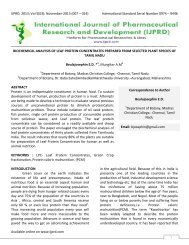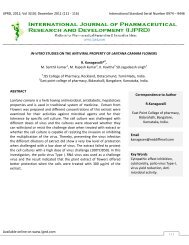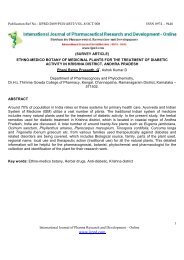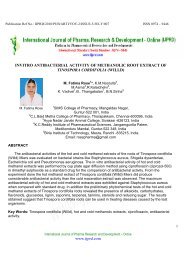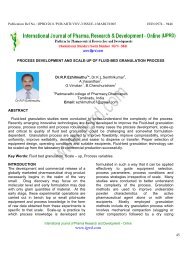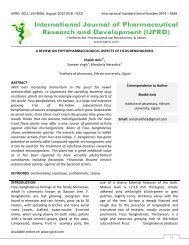Full Text - PDF - IJPRD
Full Text - PDF - IJPRD
Full Text - PDF - IJPRD
Create successful ePaper yourself
Turn your PDF publications into a flip-book with our unique Google optimized e-Paper software.
<strong>IJPRD</strong>, 2013; Vol 5(05): July-2013 (004 – 111) International Standard Serial Number 0974 – 9446<br />
--------------------------------------------------------------------------------------------------------------------------------------------------<br />
PHARMACOLOGICALLY SCREENED APHRODISIAC PLANTS- A REVIEW OF CURRENT SCIENTIFIC LITERATURE<br />
Gupta R.B.* 1 ,<br />
Kabra M.P. 1 Ahuja A., 2 Yadav R. 3<br />
1 Kota College of Pharmacy, Kota (Raj.) India<br />
2 Arya College of Pharmacy, Jaipur (Raj.) India<br />
3 Alwar College of Pharmacy, Alwar (Raj.) India<br />
ABSTRACT<br />
An aphrodisiac arouses or intensifies sexual desire. The word<br />
probably originated in the early 18 th century, gleaned from the<br />
Greek, Aphrodisiakos- arousing sexual desire, and Aphrodite-the<br />
goddess of sexual love. A variety of nutritional supplements are safe<br />
and effective libido boosters. Some of these have undergone<br />
scientific scrutiny to investigate their pharmacological mechanisms<br />
of action. Others have stood the test of time afforded by long time<br />
traditional The present review article summarizes the plant material<br />
which has been tested for its aphrodisiac activity in different<br />
experimental model (in vitro, in vivo on animal models, or in human<br />
clinical trials) and comply its claim in the different system of<br />
medicine. A brief overview about the data of percentage study in the<br />
last eighteen years duration on aphrodisiac activity of plant material<br />
was done on the basis of the CAB abstract database.<br />
KEYWORDS: Aphrodisiac plants, Mounting frequency, Intromission<br />
frequency, Ejaculation latency, Mounting latency, Intromission<br />
latency etc<br />
Correspondence Author<br />
Gupta R.B.<br />
Kota College of Pharmacy,<br />
Kota (Raj.) India<br />
Email: anu9487@gmail.com<br />
INTRODUCTION<br />
Sexual dysfunction or sexual malfunction<br />
refers to a difficulty experienced by an individual or<br />
a couple during any stage of a normal sexual<br />
activity, including desire, arousal or orgasm. A<br />
thorough sexual history and assessment of general<br />
health and other sexual problems (if any) are very<br />
important. Assessing (performance) anxiety, guilt,<br />
stress and worry are integral to the optimal<br />
management of sexual dysfunction.<br />
An aphrodisiac is defined as any food or drug that<br />
arouses the sexual instinct, induces veneral desire<br />
Available online on www.ijprd.com<br />
and increases pleasure and performance. This word<br />
is derived from ëAphroditeí the Greek goddess of<br />
love and these substances are derived from plants,<br />
animals or minerals. [1]<br />
Aphrodisiacs work in several ways. They may<br />
directly increase the physical desire to have sex,<br />
stimulate the strength and endurance of an erection<br />
in men, and increase lubrication and genital<br />
sensitivity in women. There are very few substances<br />
that are scientifically proven to do this on a<br />
consistent basis. Most supposed aphrodisiacs act as<br />
tonics, increasing virility over time, usually by<br />
103
International Journal of Pharmaceutical Research & Development ISSN: 0974 – 9446<br />
supplying nutrients which feed the glands and<br />
organs. Others may relate more to psychological<br />
and mind/body interactions.<br />
Following, is a discussion of several natural<br />
substances that both ancient shamans and modern<br />
scientist’s credit with the ability to enhance<br />
sexuality. [2]<br />
REVIEW OF LITRATURE<br />
Pharmacologically active aphrodisiac plants in<br />
experimental models:<br />
In our country with the advent of the<br />
Ayurvedists some of the medicinal plants have<br />
proven to possess a traditional as well as<br />
scientifically-proven aphrodisiac that can enhance<br />
passion, increase libido, enhance sexual<br />
performance, and help to increase the intensity of<br />
love making.<br />
REPORTED ACTIVITIES OF APHRODISIAC<br />
ACTIVITY:<br />
Anacardium occidentale:<br />
In that study the extraction of seed was<br />
carried out using a soxhlet extractor and n-hexane<br />
as solvent. 350ml of n-hexane was poured into the<br />
round bottom flask of the soxhlet apparatus.<br />
Subsequently, 20g of crushed cashew nut shell was<br />
introduced into the thimble and fitted into the<br />
soxlet extractor. Albino rats weighing between 200-<br />
250g and aged between 3-4months were selected .<br />
The rats were housed in separate cages (males and<br />
females) and kept under Normal conditions of<br />
temperature and light. The effect of cashew nut seed<br />
oil on the sexual behavior of male albino rats.<br />
Sildenafil citrate was used as the standard drug of<br />
reference. They were randomly allocated into five<br />
groups of 3 rats each, each given oral dose of 0.50<br />
ml, 1.0, and 1.5ml of the oil extract of cashew nut<br />
seed. The significant increase in the indices of<br />
sexual vigor that is mount and intromission<br />
frequencies, and the significant decrease in mount<br />
latency compared to the negative control are<br />
indications of the aphrodisiac potential of<br />
Anacardium occidentale L. oil extract from seeds . [3]<br />
Available online on www.ijprd.com<br />
Mucuna puriens:<br />
Mucuna pruriens Linn., belonging to the<br />
leguminous family (Papilionaceae), were used for<br />
treating male sexual disorders since ancient times.<br />
The effects of ethanolic extracts of the Mucuna<br />
pruriens Linn. seed on general mating behaviour,<br />
libido and potency of normal male Wister albino<br />
rats were investigated and also compared with the<br />
standard reference drug used Sildenafil citrate.<br />
Animals were divided into one control group<br />
(Group I––received saline) and four experimental<br />
groups (Groups II–V). Experimental groups were<br />
divided on the basis of the dosage of extract to the<br />
animals as follows: 150 mg/kg body weight (Group<br />
II), 200 mg/kg body weight (Group III) and 250<br />
mg/kg body weight (Group IV) while Group V<br />
received Sildenafil citrate (5 mg/kg body weight).<br />
Animals were fed PO with saline or extract or<br />
standard drug once in a day for 45 days. To analyse<br />
the mating behavior, female rats with oestrus phase<br />
were used.<br />
The extract administered PO significantly increased<br />
the mounting frequency, intromission frequency and<br />
ejaculation latency, and decreased the mounting<br />
latency, intromission latency, postejaculatory<br />
interval and inter-intromission interval. The potency<br />
test significantly increased erections, quick flips,<br />
long flips and total reflex. Therefore, the results<br />
indicated that the ethanolic extracts of Mucuna<br />
pruriens Linn. seed produced a significant and<br />
sustained increase in the sexual activity of normal<br />
male rats at a particular dose (200 mg/kg). When<br />
compared to control, all the drug-treated groups<br />
have shown drug-induced effects for a few<br />
parameters. However in Group II, there was an<br />
obvious enhancement in all parameters, without<br />
affecting the normal behaviour. When compared<br />
with the standard drug . [4]<br />
Kaempferia parviflora:<br />
In that study the Kaempferia parviflora is a<br />
Thai ginseng used by men for sexual enhancement.<br />
To determine the effect of K. parviflora ethanolic<br />
extract on the sexual behavior of male rats and its<br />
toxicity. The experiment was divided into three<br />
groups of rats given K. parviflora extract at doses of<br />
60, 120, and 240 mg/kg BW for 60 days, whilst a<br />
control group received distilled water at 1ml/day<br />
105
International Journal of Pharmaceutical Research & Development ISSN: 0974 – 9446<br />
per oral. The results showed that all groups of male<br />
rats had significantly higher courtship behavior<br />
during the first 10-minute period of observation<br />
than in the 2nd and 3rd 10-minute periods, except<br />
those receiving the highest dose of K. parviflora.<br />
They revealed the same amount of courtship<br />
behavior throughout a whole 30-minute period,<br />
which was significantly lower than the control<br />
group. There was no significant difference between<br />
treated and control groups in other sexual<br />
behaviors; mount frequency (MF), intromission<br />
frequency (IF), mount latency (ML), or intromission<br />
latency (IL). Toxicological study revealed no<br />
significant difference of hemoglobin, WBC or<br />
differential cell count. All dosages had no effect on<br />
kidney and liver function, according to the normal<br />
values of blood urea nitrogen (BUN), creatinine<br />
(Crea), aspartate aminotransferase (AST) and<br />
alanine aminotransferase (ALT). Nevertheless, the<br />
histopathological study showed a morphological<br />
change in the liver. [5]<br />
Allium tuberosum:<br />
In that study the effect seeds extract of<br />
Allium tuberosum upon the expression on male rat<br />
sexual behavior, The aphrodisiac activity of Allium<br />
tuberosumseeds n-BuOH extract was investigated in<br />
male rats. The extract (500 mg/kg body weight/day)<br />
and L-dopa (100 mg/kg body weight/day) were<br />
administered orally by gavages for 40 days. Mount<br />
latency (ML), intromission latency (IL), ejaculation<br />
latency (EL), mounting frequency (MF),<br />
intromission frequency (IF), ejaculation frequency<br />
(EF) and postejaculatory interval (PEI) were the<br />
parameters observed before and during the sexual<br />
behavior study at day 0, 10, 20, 30 and 40. The n-<br />
BuOH extract reduced significantly ML, IL, EL and<br />
PEI (p < 0.05). The extract also increased<br />
significantly MF, IF and EF (p < 0.05). These<br />
effects were observed in sexually active and<br />
inactive male rats. Present findings provide<br />
experimental evidence that the n-BuOH extract<br />
preparation of Allium tuberosum seeds possesses<br />
aphrodisiac property. [6]<br />
Camellia sinensis:<br />
In that study the Camellia sinensis (Black<br />
Tea Brew BTB) is claimed to have male sexual<br />
Available online on www.ijprd.com<br />
stimulant activity. As this claim is not scientifically<br />
tested and proven, this study was undertaken to<br />
evaluate the effects of BTB on male sexual<br />
competence.<br />
Different doses of BTB made from Sri Lankan high<br />
grown dust grade no 1 tea (84, 167 and 501 mg/ml)<br />
or water were orally administered to separate<br />
groups of rats (n = 9 per group) and 3 h later their<br />
sexual behaviour were monitored (for 15 min) using<br />
receptive females.<br />
The overall results showed that BTB possesses<br />
marked aphrodisiac activity (in terms of<br />
prolongation of latency of ejaculation shortening of<br />
mount- and intromission latencies and elevation of<br />
serum testosterone level). The aphrodisiac action<br />
had a rapid onset and appears to be mediated via<br />
inhibition of anxiety and elevation of serum<br />
testosterone level. Further, this aphrodisiac action<br />
was not associated with impairment of other sexual<br />
parameters like libido, sexual motivation, sexual<br />
arousal, sexual vigour or penile erection. BTB was<br />
also nontoxic (in terms of overt signs, liver and<br />
renal toxicity). It is concluded that BTB can<br />
function as a quick acting, safe. [7]<br />
Anacyclus pyrethrum:<br />
Anacyclus pyrethrum DC (Compositae),<br />
commonly referred to as ‘Akarkara’, is widely<br />
recognized in Ayurvedic system of Indian medicine<br />
as tonic and rejuvenator. The roots are also<br />
considered aphrodisiac and sexual stimulant.<br />
Aqueous extract of the roots was studied for its<br />
effect on sexual behavior, spermatogenesis, and<br />
sperm count. Fructose levels in seminal vesicles of<br />
albino rats were also recorded. Two doses i.e. 50<br />
and 100 mg/kg of aqueous extract on administration<br />
in albino rats showed pronounced anabolic and<br />
spermatogenic effect in animals of respective<br />
groups. The sperm count and fructose levels in<br />
seminal vesicle were markedly increased.<br />
Improvement in sexual behavior of male rats was<br />
characterized by increased mount and intromission<br />
frequency and reduced mount and intromission<br />
latency. The extract had a dose dependent influence<br />
on sperm count and seminal fructose concentration<br />
which increased significantly. The use of medicinal<br />
plants in the management of several ailments is<br />
gaining popularity nowadays. [8]<br />
106
International Journal of Pharmaceutical Research & Development ISSN: 0974 – 9446<br />
Massularia acuminate:<br />
Massularia acuminata, one of such plants is<br />
commonly used as chewing sticks due to its<br />
antimicrobial activity and the aqueous extract of its<br />
stem as an aphrodisiac. Aphrodisiac activity in<br />
some plants may be due to androgen increasing<br />
property of its phytochemicals.<br />
In that study the the androgenic potentials of<br />
aqueous extract of Massularia acuminata stem in<br />
male rats for 21 days. Male rats weighing between<br />
220 and 260 g were completely randomized into<br />
four groups: A, B, C and D. Group A, the control<br />
received orally 1 ml of distilled water (the vehicle)<br />
while groups B, C and D were orally administered<br />
with 1ml each corresponding to 250, 500 and 1000<br />
mg/kg body weight of the plant extract, respectively<br />
for 21 days. Rats were sacrificed 24 h after 1, 7 and<br />
21 days. Compared with the control, extract<br />
administration at all the doses produced significant<br />
increase (P < 0.05) in testes–body weight ratio,<br />
testicular protein, glycogen, sialic acid, cholesterol,<br />
testosterone, luteinizing and follicle stimulating<br />
hormone concentrations throughout the period of<br />
administration. Testicular gamma glutamyl<br />
transferase activities were decreased significantly<br />
(P < 0.05) after the first dose and was sustained<br />
throughout the experimental period.<br />
The available evidence in that study suggests that<br />
aqueous extract of Massularia acuminata stem has<br />
androgenic potential which may stimulate male<br />
sexual maturation and enhance normal testicular<br />
function. [9]<br />
Butea frondonsa:<br />
In that study, the aphrodisiac activity of<br />
Butea frondonsa Koen. ex Roxb (Papillionaceae)<br />
bark extract was investigated. The extract (400<br />
mg/kg body wt./day) was administered orally by<br />
gavage for 28 days. Mount latency (ML),<br />
intromission latency (IL), ejaculation latency (EL),<br />
mounting frequency (MF), intromission frequency<br />
(IF), ejaculation frequency (EF) and postejaculatory<br />
interval (PEI) were the parameters<br />
observed before and during the sexual behavior<br />
study at day 0, 7, 10, 14, 21, and 28. The extract<br />
reduced significantly ML, IL, EL and PEI (p <<br />
0.05). The extract also increased significantly MF,<br />
Available online on www.ijprd.com<br />
IF and EF (p < 0.05). These effects were observed<br />
in sexually active and inactive male rats. [10]<br />
Asparagus racemosus:<br />
In that study the the hydro-alcoholic extract<br />
of Asparagus racemosus root at higher<br />
concentration (400 mg/kg body weight) showed<br />
significant aphrodisiac activity on male wistar<br />
albino rats as evidenced by an increase in number of<br />
mounts and mating performance. On the other hand,<br />
hydro-alcoholic extract at lower dose (200 mg/kg.<br />
body weight) and aqueous extract (400 mg/kg body<br />
weight) showed moderate aphrodisiac property.<br />
Thus, in experimental rats, the results of the present<br />
study suggest that the extracts of Asparagus<br />
racemosus exert significant aphrodisiac activity. [11]<br />
Tinospora cordifolia<br />
Tinospora cordifolia is an herbaceous vine<br />
of the family Menispermaceae. In that study, the<br />
total extracts were tested for their constituents and<br />
tested for aphrodisiac activity in experimental rats.<br />
The preliminary phytochemical screening of<br />
hydroalcoholic and aqueous extracts of the stems of<br />
Tinospora cordifolia showed the presence of<br />
alkaloids, carbohydrates, glycosides, steroids,<br />
proteins, saponins, gums and mucilages. The<br />
hydroalcoholic extract of Tinospora cordifolia stem<br />
at higher concentration (400 mg/kg body weight)<br />
showed significant aphrodisiac activity on male<br />
wistar albino rats as evidenced by an increase in<br />
number of mounts and mating performance. On the<br />
other hand, hydroalcoholic extract at lower dose<br />
(200 mg/kg body weight) and aqueous extract (400<br />
mg/kg body weight) showed moderate aphrodisiac<br />
property. Thus, in experimental rats, the results of<br />
the present study suggest that the extracts of<br />
Tinospora cordifolia exert significant aphrodisiac<br />
activity. Further, detailed studies are needed to<br />
know whether in vivo administration of the extracts<br />
is beneficial for patients suffering from sexual. [12]<br />
Argeria nervosa:<br />
The aphrodisiac property of Argeria nervosa<br />
was studied in male mice. The root, flower and, to<br />
some extent, leaf (homogenate in 2% gum acacia)<br />
of the plant showed aphrodisiac activity as<br />
evidenced by an increase in mounting behavior of<br />
107
International Journal of Pharmaceutical Research & Development ISSN: 0974 – 9446<br />
mice. When different extracts of the root were<br />
tested, the activity was found in the alcohol extract<br />
(200 mg/kg; p.o, single dose). The extract, 1 hr after<br />
administration, stimulated mounting behavior of<br />
male mice in a concentration-dependent manner.<br />
The root- or flower-treated male mice also exhibited<br />
a remarkable increase in mating performance.<br />
Further, the number of males was found to be more<br />
among the pups fathered by the herbal drug-treated<br />
mice compared to those by the control mice. Thus,<br />
the plant has promising potential to be developed<br />
into an effective medicine for stimulating male<br />
sexual activity. [13]<br />
Safranal:<br />
The aphrodisiac activities of Crocus sativus<br />
stigma aqueous extract and its constituents, safranal<br />
and crocin, were evaluated in male rats. The<br />
aqueous extract (80, 160 and 320 mg/kg body wt.),<br />
crocin (100, 200 and 400 mg/kg body wt.), safranal<br />
(0.1, 0.2 and 0.4 ml/kg), sildenafil (60 mg/kg body<br />
wt., as a positive control) and saline were<br />
administered intraperitoneally to male rats.<br />
Mounting frequency (MF), intromission frequency<br />
(IF), erection frequency (EF), mount latency (ML),<br />
intromission latency (IL) and ejaculation latency<br />
(EL) were the factors evaluated during the sexual<br />
behavior study. Crocin, at all doses, and the extract,<br />
especially at doses 160 and 320 mg/kg body wt.,<br />
increased MF, IF and EF behaviors and reduced EL,<br />
IL and ML parameters. Safranal did not show<br />
aphrodisiac effects. The present study reveals an<br />
aphrodisiac activity of saffron aqueous extract and<br />
its constituent. [14]<br />
Pedalium murex:<br />
It has been suggested that chronic ethanol<br />
exposure may result in testicular damage and<br />
infertility in males. Petroleum ether extract of<br />
Pedalium murex, family Pedaliaceae (PEPM), is<br />
evaluated in this study for its ability to increase<br />
aphrodisiac activity and to cure ethanol induced<br />
germ cell damage and infertility in male rat models.<br />
Doses of 200 and 400 mg/kg of PEPM showed a<br />
significant increase (P < 0.01, P < 0.001) in mating<br />
and mounting behaviour. The effect on fertility<br />
factors such as total body weight, percentage of<br />
pregnancy, litter size were also significantly<br />
increased (P < 0.01) in comparison with the<br />
Available online on www.ijprd.com<br />
ethanol-treated group. Significant increases in<br />
sperm motility and count were observed in PEPM<br />
treated groups in a dose-dependent manner (P <<br />
0.01; P < 0.001) as compared with the ethanoltreated<br />
group. Similarly, reductions in the<br />
percentage of abnormal sperm were noted in<br />
animals treated with PEPM 400 mg/kg. The effects<br />
of PEPM on total protein, total cholesterol and<br />
testosterone were satisfactory, the levels being<br />
increased significantly for protein (P < 0.05),<br />
cholesterol (P < 0.01) and testosterone (P < 0.05) by<br />
400 mg/kg PEPM. Microtome sections of the testes<br />
of animals treated with 400 mg/kg PEPM exhibited<br />
restoration and recovery of germinal cells and the<br />
luminal spermatozoa and were comparable with the<br />
control group animals. These effects of PEPM make<br />
this natural herb ideal as an aphrodisiac and a potent<br />
fertility enhancing drug. [15]<br />
Trichopus zeylanicus:<br />
Administration of Trichopus zeylanicus leaf<br />
(ethanol extract) to male mice stimulated their<br />
sexual behavior as evidenced by an increase in<br />
number of mounts and mating performance. This<br />
activity of the ethanol extract was concentration<br />
dependent and destroyed by heat treatment at 100°C<br />
for 15 min. Although oral administration of a single<br />
dose (200 mg:kg) was effective, daily<br />
administration of the extract for 6 days was found to<br />
be more effective. The pups fathered by the drug<br />
treated mice were found to be normal with reference<br />
to fetal growth, litter size and sex ratio. The water<br />
as well as n-hexane extracts of the plant leaf were<br />
inactive. [16]<br />
Microdesmis keayana:<br />
The aphrodisiac properties of Microdesmis<br />
keayana J. Le´onard root extract and major isolated<br />
alkaloids were evaluated by observing the sexual<br />
behavior of male rats. Aqueous extract (150 mg/kg<br />
body weight) and pure alkaloids (3 mg/kg body<br />
weight) were administered orally by gavage to male<br />
rats. Latent times of observation, intromission and<br />
ejaculation, mounting behavior, number of<br />
intromissions and mating performances were<br />
evaluated and compared to those obtained with<br />
untreated rats in the presence of receptive and nonreceptive<br />
females. The results have shown that<br />
108
International Journal of Pharmaceutical Research & Development ISSN: 0974 – 9446<br />
aqueous extract and alkaloids of M. keayana<br />
stimulate sexual parameters in rats’ sexual behavior.<br />
A short-term toxicity study undertaken to establish<br />
the therapeutic index of aqueous extract, showed<br />
that a high dose of the extract (2 g/kg body weight)<br />
caused no change in rat behavior and toxicity. [17]<br />
Turnera aphrodisiaca:<br />
In that study the investigation, various<br />
extracts (petroleum ether, chloroform, methanol and<br />
water), alkaloidal fraction, and volatile oil of T.<br />
aphrodisiaca were screened for aphrodisiac activity<br />
in mice. Mounting behaviour was taken as a<br />
parameter to screen aphrodisiac activity.<br />
Chloroform extract exhibited significant activity at<br />
a dose of 200 mg/kg, p.o. while methanol extract<br />
showed aphrodisiac activity at a lower dose, i.e., 50<br />
mg/kg, p.o.. Volatile oil of T. aphrodisiaca was<br />
found to be devoid of aphrodisiac activity.<br />
Qualitative phytochemical screening showed the<br />
presence of alkaloids in chloroform and methanol<br />
extracts. Therefore, the alkaloidal fraction was<br />
isolated from aerial parts of T. aphrodisiaca, and<br />
tested for aphrodisiac activity at dose levels of 25,<br />
50, 75, or 100 mg/kg, p.o. A dose dependent<br />
increase in activity was observed upon acute as well<br />
as sub acute administration of alkaloidal fraction<br />
chloroform and methanol extracts were found to be<br />
active. Chloroform extract exhibited maximum<br />
aphrodisiac activity at the dose of 200 mg/kg while<br />
methanol extract at the dose of 50 mg/kg during 2 nd<br />
h of test with respect to control. [18]<br />
Eurycoma longifolia:<br />
In that study Eurycoma longifolia<br />
evaluated on sexual behavior (including both<br />
motivation and copulatory performance) of sexually<br />
sluggish and impotent male rats.<br />
The root powder of the plant was orally<br />
administered to adult Sprague–Dawley male rats,<br />
classified as sexually sluggish or impotent taking in<br />
account their behavior in pre-experimental tests.<br />
Groups of 8 animals each were submitted to three<br />
different types of treatment: (1) acute at 3 dose<br />
levels (250, 500 and 1000 mg/kg); (2) subacute<br />
(daily for 6 days) at the dose of 500 mg/kg and (3)<br />
subchronic (daily for 12 days) at the same dose (500<br />
mg/kg). Mount, intromission and ejaculation<br />
Available online on www.ijprd.com<br />
latencies and post-ejaculatory interval were<br />
recorded during the mating test in order to evaluate<br />
sexual performance. In addition the partner<br />
preference test was used to assess sexual<br />
motivation. Testosterone serum levels were<br />
measured in subacutely treated rats and compared<br />
with the values of controls receiving vehicle.<br />
Eurycoma longifolia root improved sexual<br />
performance but not motivation in sluggish rats<br />
after acute or subacute administration. The effect<br />
could be mainly described to increased testosterone.<br />
[19]<br />
Spilanthes acmella:<br />
In that study, Characterization of ethanolic<br />
extracts of the Spilanthes acmella flower and its<br />
effect on general mating pattern, penile erection and<br />
serum hormone levels of normal male Wistar albino<br />
rats were investigated and compared with sildenafil<br />
citrate. For assessment of sexual behavior, animals<br />
were divided into five groups of eight male rats.<br />
The extracts (50, 100 and 150 mg/kg body<br />
weight/day) and sildenafil citrate (5 mg/kg body<br />
weight/day) (positive control) were administered<br />
orally for 28 days. The behavioral and sexual<br />
parameters were observed at days 0, 15, 28 and<br />
after a lapse of 7 and 14 days of discontinuance of<br />
drug treatment. Five N-isobutylamides, one 2-<br />
methylbutylamide and one 2-phenylethylamide<br />
were identified. The orally administered extract had<br />
a dose dependent positive effect on mounting<br />
frequency, intromission frequency and ejaculation<br />
frequency and the most significant effects (p < 0.05)<br />
were observed at 150 mg/kg treatment, even after a<br />
lapse of 7 and 14 days of discontinuance of drug<br />
treatment. A dose dependent effect was also<br />
observed on the FSH, LH and testosterone serum<br />
levels. With 150 mg/kg of ethanolic extract the<br />
values for FSH, LH and testosterone were<br />
3.10±0.25 mlU/ml,6.87±0.18 mlU/ml and<br />
3.72±0.12 ng/ml, respectively. In vitro nitric oxide<br />
release was 21.7±2.9 _M, which was significantly<br />
higher compared to the control group (p < 0.01). [20]<br />
Fadogia agrestis:<br />
109
International Journal of Pharmaceutical Research & Development ISSN: 0974 – 9446<br />
In that study the effects of administration of<br />
aqueous extract of Fadogia agrestis (Schweinf. Ex<br />
Hiern) stem on some testicular function indices of<br />
male rats (Rattus norvegicus) and their recovery<br />
potentials for 10 days were investigated. Rats were<br />
grouped into four: A, B, C and D where A (the<br />
control) received orally 1ml of distilled water (the<br />
vehicle), B, C and D(the test groups) received orally<br />
on daily basis graded doses of 18, 50 and 100<br />
mg/kg body weight of the plant extract,<br />
respectively, for 28 days. The alterations brought<br />
about by the aqueous extract of Fadogia agrestis<br />
stem are indications of adverse effects on the male<br />
rat testicular function and this may adversely affect<br />
the functional capacities of the testes. The recovery<br />
made at the dose of 18 mg/kg body weight as used<br />
in folklore medicine suggests that it does not exhibit<br />
permanent toxicity at this dose. [21]<br />
CONCLUSION:<br />
The search for natural supplement from<br />
medicinal plants is being intensified probably<br />
because of its fewer side effects, its ready<br />
availability and less cost. All the plants in this<br />
review have exhibited significant<br />
pharmacological activity. The herbs can be<br />
effective aphrodisiacs. Moreover, isolation and<br />
identification of active constituents from plants<br />
may bring a dynamic change in the modern<br />
world.<br />
Many of the plant materials showed positive<br />
aphrodisiac activities in animals. For the<br />
determination of the safety and effectiveness of<br />
these substances for sexual enhancement it is<br />
necessary to test pre-clinically in animals and<br />
clinically in human being before consuming the<br />
drug. Further studies are also needed to check the<br />
mechanism that underlie behind such activity.<br />
Demands of natural aphrodisiacs require<br />
increasing studies to understand their effects on<br />
humans and strengthen relationships to its safety.<br />
Due to unavailability of the safety data, unclear<br />
mechanisms, and lack of knowledge to support<br />
the extensive use of these substances, uses of<br />
these products can be harmful to the human<br />
being. With more clinical data, exact mechanisms<br />
of action, safety profile, and drug interaction with<br />
Available online on www.ijprd.com<br />
other uses of these aphrodisiacs plant materials,<br />
treating sexual disorder can become fruitful.<br />
REFERENCES<br />
1. Ahmed, I., Eiian, S., 2012. Erectile dysfunction in<br />
Arab countries. Part II: Diagnosis and treatment<br />
Arab Journal of Urology 10,104–109<br />
2. Mélanie, R., 2012. A systematic literature review<br />
of 10 years of research on sex/gender and pain<br />
perception – Part 2: Do biopsychosocial factors<br />
alter pain sensitivity differently in women and<br />
men? PAIN 153,619–635<br />
3. Valentine, CM., Isaac, K., 2012. Aphrodisiac<br />
activity of oils from Anacardium occidentale<br />
L. seeds and seed shells. Phytopharmacology<br />
2(1) ,81-91<br />
4. Suresh, Elumalai, P., Seppan, P., 2009. Doseand<br />
time-dependent effects of ethanolic extract<br />
of Mucuna pruriens Linn. Seed on sexual<br />
behaviour of normal male rats . Journal of<br />
Ethnopharmacology 122 , 497–501.<br />
5. Paiwan, S., Kanokporn, S., Supap S., and<br />
Songkiet ,S., 2006.Effect of Kaempferia par<br />
viflora Wall . Ex. Baker on Sexual Activity of Male<br />
Rats and its Toxicity Southeast asian j trop med<br />
public health. Vol. 37 (suppl. 3) ,210-215<br />
6. Hu, G., Lu Y, Mao R.,Wei D., Ma Z., Zhang,H.,<br />
2009.Aphrodisiac properties of Allium<br />
tuberosum seeds extract. Journal of<br />
Ethnopharmacology 122, 579–582<br />
7. Ratnasooriya, WD., Farnado, T.S.P., 2008.Effect<br />
of black tea brew of Camellia sinensis on sexual<br />
competence of male rats. Journal of<br />
Ethnopharmacology 118 ,373–377<br />
8. Vikas, S, Mayank,T, Chauhan N.S., Dixit V. K.<br />
.,2009. Evaluation of the Anabolic, aphrodisiac<br />
and reproductive activity of Anacyclus<br />
Pyrethrum in Male Rats .Sci Pharm.77,97–110<br />
9. Musa, TY., Musbau, A., Adenike, T., Ayoade A.,<br />
2008. Androgenic potentials of aqueous extract<br />
of Massularia acuminata (G. Don) Bullock ex<br />
Hoyl. stem in male Wistar rats. Journal of<br />
Ethnopharmacology 11 ,508–513<br />
10. Ramachandran, S., Sridhar,Y., Kishore GS.,<br />
Saravanan, MJ., Thomas, L., Anbalagan, N., and<br />
Sridhar, SK., 2004. Aphrodisiac activity of Butea<br />
110
International Journal of Pharmaceutical Research & Development ISSN: 0974 – 9446<br />
frondosa Koen. ex Roxb. extract in male rats<br />
Phytomedicine 11, 165–168,<br />
11. Javeed, AW., Rajeshwara, N. Achur, Nema RK.,<br />
2011.Phytochemical Screening and aphrodisiac<br />
activity of Asparagus Racemosus. International<br />
Journal of Pharmaceutical Sciences and Drug<br />
Research. 3(2), 112-115<br />
12. Javeed, AW., Rajeshwara, N., Achur., Nema. RK.,<br />
2011 .Phytochemical screening and aphrodisiac<br />
property of Tinospora cordifolia. International<br />
Journal of Pharmaceutical and Clinical Research<br />
3(2),21-26<br />
13. Subramoniam, A .2007’Aphrodisiac property of<br />
the elephant creeper Argyreia nervosa J<br />
Endocrinol Reprod 11:2, 82 – 85<br />
14. Hosseinzadeha,H., Ziaeeb, T., Sadeghi A.,<br />
2008.The effect of saffron, Crocus sativus<br />
stigma, extract and its constituents, safranal and<br />
crocin on sexual behaviors in normal male rats<br />
.Phytomedicine 15 , 491–495<br />
15. Gunasekaran, B., Muralidharan,<br />
P.,Satyanarayana P., 2010.Aphrodisiac activity<br />
and curative effects of Pedalium murex<br />
(L.)against ethanol-induced infertility in male<br />
rats. Turk J Biol 34 ,153-163<br />
16. Subramoniam, A., Madhavachandran, V.,<br />
Rajasekharan, S., Pushpangadan, P.,<br />
1997.Aphrodisiac property of Trichopus<br />
zeylanicus extract in male mice. Journal of<br />
Ethnopharmacology 57 ,21–27<br />
17. Zamble,´A., Sahpaza, S., Brunetb, C.,<br />
Bailleul,F., 2008.Effects of Microdesmis keayana<br />
roots on sexual behavior of male rats.<br />
Phytomedicine 15 ,625–629<br />
18. Kumar S., 2009. Evaluation of aphrodisiac<br />
activity of Turnera aphrodisiaca. International<br />
Journal of Pharmacognosy and Phytochemical<br />
Research ; 1(1): 1-4P.<br />
19. Zanoli ., 2009. Influence of Eurycoma longifolia<br />
on the copulatory activity of sexually sluggish<br />
and impotent male rats. Journal of<br />
Ethnopharmacology 126 ,308–313<br />
20. Sharma, V., 2011. Spilanthes acmella ethanolic<br />
flower extract: LC–MS alkylamide profiling and<br />
its effects on sexual behavior in male rats.<br />
Phytomedicine 18 , 1161– 1169<br />
1. Musa, TY., 2008. Effects of oral administration<br />
of aqueous extract of Fadogia agrestis<br />
(Schweinf. Ex Hiern) stem on some testicular<br />
function indices of male rats 2008.Journal of<br />
Ethnopharmacology 115 ,288–292.<br />
*****<br />
Available online on www.ijprd.com<br />
111



